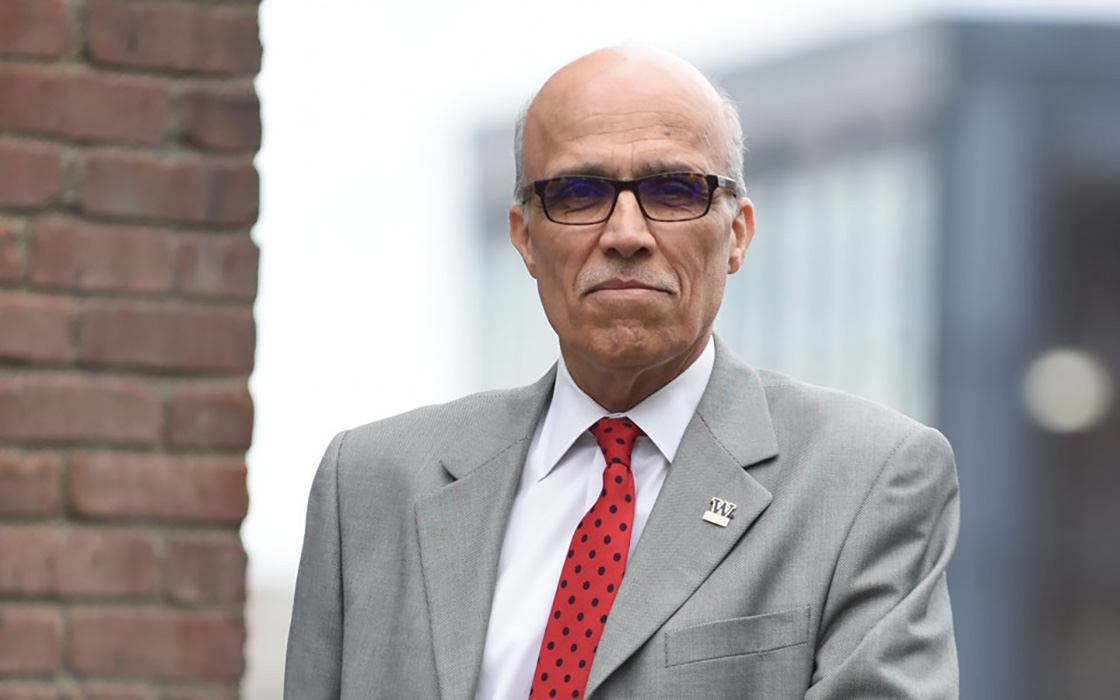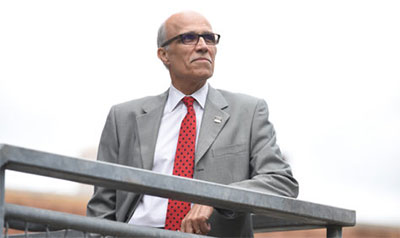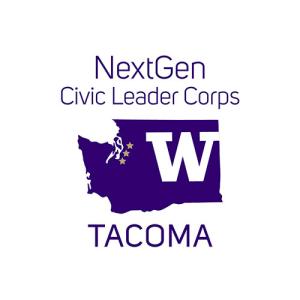
Ali Modarres Is a Man About Towns
Dr. Ali Modarres came to UW Tacoma in 2013 as the new director of the Urban Studies program. In a relatively short time, he has emerged as an indispensable campus and community leader, in both cases serving as an emollient lubricating the sometimes squeaky machinery of governance.
Premier Media's new South Sound Business magazine ran a cover profile of Modarres in its June issue, which we are pleased to reprint in full, with permission.
Man About Towns
By Todd Matthews, June 6, 2018

Urban Studies expert Dr. Ali Modarres sees South Sound economic opportunities and challenges

Few people study the South Sound as closely as Dr. Ali Modarres. When our region’s business leaders and policymakers want to know the latest economic and housing trends, Modarres increasingly is the person they turn to for expertise. And why not? He is a professor at the University of Washington Tacoma and the director of the school’s Urban Studies program. But he doesn’t limit his purview to the naturally-lit, high-ceilinged, book-lined office he occupies in the Pinkerton Building on the UW Tacoma campus.
MAN ABOUT TOWNSDR. ALI MODARRESAge Education City of Residence The Power Broker or The Death and Life of Great American Cities? Tacoma vs. Seattle & a legitimate rivalry, or overblown (and why or why not)? |
If you want to ask him about, say, which South Sound industry sector is next poised to boom, or how to spur local economic growth, it’s likely you will find Modarres offering his insights outside of academia—whether it’s as a presenter at the annual South Sound Summit; serving on local commissions aimed to address issues of minimum wage and affordable housing; or as a member of the South Sound Alliance, a leadership council comprised of Pierce County and South King County cities and towns that aims to employ data-driven strategies to bolster local communities and economies.
It’s all entirely by design. When Modarres was hired by UW Tacoma in 2013, he made it clear that his opinions, experiences, and insights would be known by anyone who might be interested—scholars, policymakers, or everyday residents alike.
“Universities should be positioned as the very public places that they are and should bring to the table all their resources to benefit the communities they serve,” Modarres said at that time. “It seems to me we could do more.”
“There are few land-use and transportation leaders in Pierce County who have not worked with or been influenced by the work of Ali Modarres,” said Christopher Wierzbicki, executive director of Futurewise, a Seattle nonprofit with an influential and statewide reach on issues such as land-use planning, transportation, affordable housing, and the economy. In March, Futurwise named Modarres its community champion in the organizaton’s annual Livable Community Awards. “His leadership and facilitation skills are sorely needed in a regional environment that seeks to define themselves—and their economy—as distinct from Seattle.”
Modarres’ interests touch on issues such as social geography, immigration, urban development, and planning policy, and tap a well of knowledge that spans nearly four decades. He grew up in Iran, emigrated to the United States in 1978, and earned bachelor’s and master’s degrees in landscape architecture from the University of Arizona. At the Arizona Department of Environmental Quality, he worked as an environmental planner while he earned his Ph.D., and later was hired as a transportation analyst for the Pima Association of Governments in Tucson, Arizona.
After nearly 12 years in the Southwest, he moved to Los Angeles and taught geography as a professor at California State University.
Modarres recently spoke to South Sound Business about King and Pierce counties’ competing economies, the downtown Tacoma departures of large-scale employers Russell Investments in 2010 and State Farm this year, and the region’s recent bid for Amazon HQ2.
Q: When you were hired by the University of Washington Tacoma and moved to the area, what were your first impressions of Tacoma and Pierce County?
A: I had never seen the place, even though I had been to Seattle multiple times. Tacoma was stunning and the coastal areas were just absolutely gorgeous, but you had to get on exit 133 to see it!
I found it fascinating that Interstate 5 was designed in such a way that it hides the place, as opposed to making it more visible. Tacoma Dome doesn’t help, either.
As for Pierce County, I was first puzzled by the number of small jurisdictions — Puyallup, Fife, University Place, Lakewood, etc. They all have their unique character, and their unique identity. For somebody like me, who was coming from the outside, I could not understand why there wasn’t a higher level of connectedness and collaboration among these jurisdictions. Shouldn’t there be a singular, agreed-upon vision for this region?
My first and lasting impression of the South Sound was one of stunning beauty and fragmentation. This is a place to raise a family and enjoy the environment, with a good chance of commuting north to pay for it.
Q: According to your data and the U.S. Census Bureau, 153,000 people leave Pierce County each weekday for high-paying jobs elsewhere in software development, aerospace, and management. Meanwhile, 92,000 people commute to Pierce County each day for work. Describe what’s happening.
A: Making $30 an hour versus making $20 or $25 an hour — well, there are 2,000 hours in a year. At $5 an hour, that’s $10,000 more (annually). If you have a local job and there is another job 20 miles away and it pays that much more every year, there is no chance you will say, “Oh, you know what? I don’t want the extra money.”
It’s not a puzzle. It’s actually quite clear why they do what they do.
Q: How does Pierce County reduce that outflow of workers?
A: We need to look at the number of people who could establish smaller businesses and be their own bosses. What are the ways that we can grow small- and medium-sized companies, or attract them, or help them grow so at least a portion of this commuting population stays put?
Q: Were you living in Pierce County and working at UW Tacoma when Russell Investments left Tacoma for Seattle?
A: Russell had (already) left when I got here in 2013. When people said, “Oh, my gosh, State Farm is coming! This is the best thing ever!” I thought, “Congratulations; you filled a building.” If you always have to worry about how to fill up a building, not where your economy is, it says to me that real estate is a much more important sector to you. As long as the rent is paid, anybody can fill up that building.
Recruitment of larger companies is OK. But when a large company leaves, the devastation for our region is much more than when a large company leaves Seattle. If a company of 500 employees leaves downtown Seattle or downtown Bellevue, yes; it does have an impact. But you don’t wake up in the middle of the night worrying about that. For us, when a company of that size leaves, we could shrug it off, but not really.
If you have 100 companies of 20 people each, that’s 2,000 employees. Even if 10 percent of them don’t work out, you still have most of them. But if a company comes in with 2,000 people and they leave, you’ve lost (everything).
Q: Is there an economic trend in Pierce County that has caught your attention?
A: The number of highly trained individuals with higher degrees in Pierce County has been going up. In 2016, about 33 percent of the Pierce County population 18 and older had a bachelor’s degree or higher. In 2010, the rate was about 28 percent.
I refer to this region as an education — and potentially innovation — region. Our pool of labor is expanding; our local expertise is growing. People come here to get educated. If we were the kind of economy that could keep them here, they would stay.
Yet, when it comes time to get a job, they have to ship out. Some of them are staying behind and trying to experiment with the idea of being self-employed. These are entrepreneurs in the making.
We need to incentivize. We need to begin to say, “Yeah; we have incubation programs, but can we really notch it up here with shared spaces, shared resources, buildings where these folks can have a cubicle, et cetera?” Put your money on your local talent. You don’t have to write an expensive proposal to keep them here. They would be happy with a small loan to just get their basic stuff together. They would be happy with business assistance when they need your help, when they are ready to go from just themselves to having two employees.
Those are the sort of things that I think we need to be doing.
Q: The City of Tacoma and Pierce County were among the nearly 240 cities and regions that responded to Amazon’s call for proposals regarding the company’s plan to build a second headquarters, or HQ2. What are your thoughts on that process?
A: The whole idea of putting the proposal together actually allowed people to see what they have and what they don’t have, so it was good research. That Amazon got these cities scrambling and spending money to put these proposals together tells you about the power of a single conglomeration. God help us if every company of that size decides that’s the way they are going to do it from now on. Why? Because they get the public sector to pay for their research.
Q: It seemed like some cities and regions never really had a chance, but they applied anyway.
A: More than half of them knew they had no chance, but it was a gesture they had to make.
What becomes uncomfortable for me is that, on the one hand, there is a benefit of doing an analysis of your economic, demographic, and transportation landscapes, and have that information so you can go recruit smaller companies and other types of companies. But having a company commission that (analysis), and have the public sector spend that kind of money, that’s the part that makes me concerned — that a single company can get so many jurisdictions to do its research.
I think Amazon could have said, “If you don’t fit into (our criteria), don’t bother because we would hate for you to spend your public dollars on it.”



